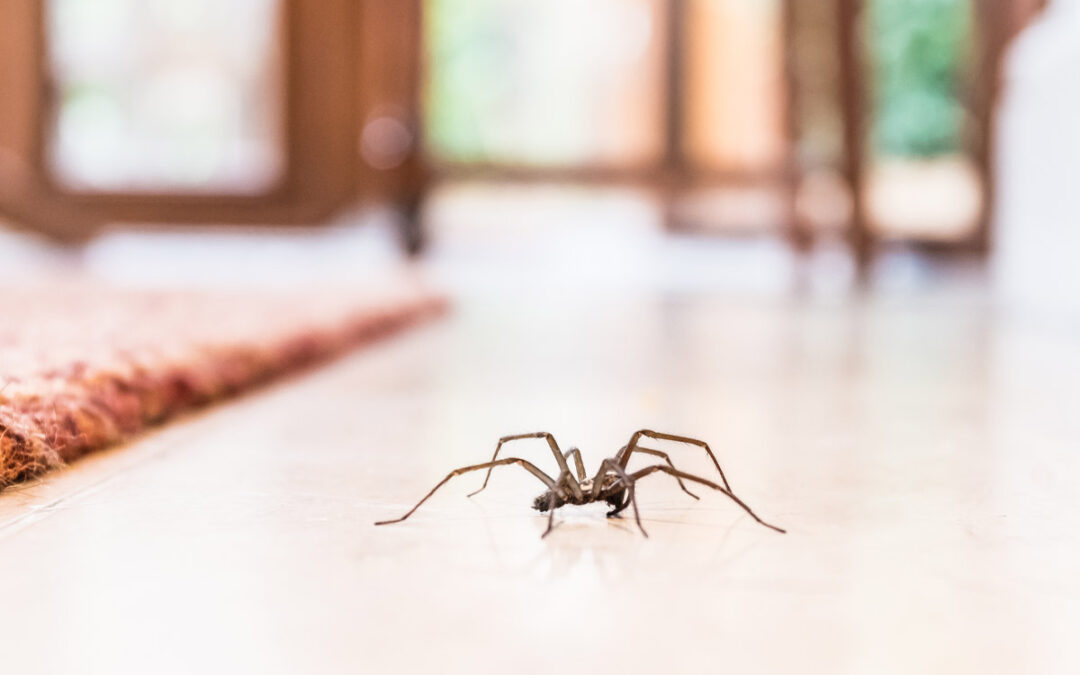As the first hard frosts blanket the ground and the warmth of your home radiates into the cold night, you’ve essentially hung out a vacancy sign. Spiders, and the insects they hunt, are on a desperate search for a winter shelter.
They are experts at finding the smallest flaws in your home’s defences. This seasonal invasion isn’t just an annoyance; it’s a sign of a breach. And the most effective response isn’t a rolled-up newspaper, it’s preventative pest control.
The Real Goal of Autumn Pest Control
When people think of pest control, they often picture an emergency response to an existing problem. The true value, however, lies in prevention. Autumn is the critical season for this.
A professional service in November isn’t just about removing the spiders you see; it’s about creating a comprehensive barrier that stops them (and their food source) from ever getting in. This is accomplished through a strategy of exclusion (sealing the home) and environmental management, making your home an unappealing fortress before the snow truly sets in.
Why November? The Great Spider Misconception
It’s a common belief that all spiders come indoors in the fall to get warm. The reality is a bit more complex and reveals why your home is so attractive.
The “Indoor” vs. “Outdoor” Spiders
Canada is home to two main groups of spiders relevant to homeowners.
- “Indoor” Spiders: Species like the Common House Spider (Parasteatoda tepidariorum) and the Cellar Spider (Pholcus phalangioides) are adapted to live indoors year-round. They have likely been in your home all along, quietly living in basements, attics, and crawl spaces. You simply see them more in the fall. Why? Autumn is mating season. The males, which are typically more reclusive, go on the move, wandering your halls and rooms in search of a female.
- “Outdoor” Spiders: This is the group that truly “invades” in November. Species like the Wolf Spider (family Lycosidae) and Grass Spiders (family Agelenidae) are hunters that live in your lawn, garden, and woodpiles all summer. They cannot survive a hard Canadian freeze. The dropping temperatures are a direct threat, forcing them to find a sheltered spot (a “hibernaculum”) to overwinter. Your warm, dark, and food-filled basement or wall void is the perfect five-star resort.
They Are Following the Food
Spiders are predators. Their presence is a direct indicator of another pest problem. As the November chill sets in, other insects (cluster flies, stink bugs, boxelder bugs, and crickets) are also flooding into your home for warmth. For a spider, this is a pre-stocked, self-replenishing pantry. A spider infestation is often a symptom of a larger insect infestation.
The Spider’s Superpower: Finding Your Home’s Flaws
Spiders don’t need much of an opening. A tiny crack, a small tear, or a gap the width of a credit card is a wide-open door. A professional pest technician is trained to spot these vulnerabilities that most homeowners overlook.
Key entry points include:
- Foundation Gaps: The most common entry point. Spiders and insects crawl up the foundation and find tiny, hairline cracks in the concrete or, more often, the gap where the foundation meets the wooden sill plate of the house.
- Worn-Out Weather-Stripping: The rubber or vinyl seals at the bottom of exterior doors, especially garage doors, become brittle, cracked, and warped over time. This leaves a gap that ground-dwelling spiders, like the formidable wolf spider, can easily slip under.
- Damaged Screens: A small tear in a window or door screen, or a screen that doesn’t sit perfectly flush in its frame, is a simple entry point.
- Utility Penetrations: This is a hidden superhighway. Look where pipes, wires, and vents enter your home: gas lines, air-conditioning units, dryer vents, and hydro/cable lines. The holes drilled for these utilities are rarely sealed perfectly, leaving a small, protected gap that pests love.
- Soffits, Eaves, and Vents: Spiders are excellent climbers. They will scale your siding and enter through unscreened roof vents, attic vents, or gaps in the soffits (the underside of your roof overhang).
- “Trojan Horse” Entries: Spiders and their egg sacs can be accidentally carried in on firewood, outdoor decorations, and potted plants that are brought indoors for the winter.
Integrated Pest Management: The Complete Solution
A can of spray won’t control a spider problem. The only long-term, effective strategy is Integrated Pest Management (IPM), a multi-faceted approach that addresses the root causes.
According to a study, IPM is crucial for reducing and controlling brown recluse spider populations, addressing health and real estate concerns (Vetter et al., 2018). While this dangerous species isn’t established in Canada, the IPM principle is universal. It remains the most effective, intelligent method for controlling all spider populations, from harmless cellar spiders to the more intimidating wolf spider.
An IPM plan has three main parts:
1. Exclusion (Sealing the Building)
This is the single most important action. A professional technician will “spider-proof” the home by sealing all the entry points:
- Applying high-quality silicone caulk to all cracks in the foundation and around utility penetrations.
- Installing new, tight-fitting door sweeps and weather-stripping on all exterior doors.
- Repairing or replacing all damaged window and door screens.
- Installing fine-wire mesh over all vents (attic, gable, dryer) that lead outdoors.
- Packing small, difficult-to-caulk gaps (like around pipes) with coarse-grade steel wool or copper mesh, which pests cannot chew through.
2. Sanitation (Removing Food and Shelter)
This component involves making your property less attractive.
- Interior:

- Regular, thorough vacuuming is a spider’s worst enemy. Target corners, baseboards, under furniture, and in closets. Be sure to remove all visible webs and egg sacs.
- Reduce clutter. Spiders are secretive and thrive in undisturbed areas. Piles of cardboard boxes, old magazines, and stored items in basements and attics are ideal hiding and breeding grounds. Store items in sealed plastic totes, not cardboard.
- Exterior:
- Move firewood piles at least 6 metres away from the house and store them on a rack off the ground.
- Rake leaves, grass clippings, and other lawn debris away from the foundation.
- Trim back all vegetation, shrubs, and tree branches so nothing is touching your house. This creates a “dead zone” that spiders are less likely to cross.
- Change your exterior lighting. Bright white lights are a beacon for the insects that spiders eat. Switch to yellow “bug light” bulbs or motion-sensor lights, which are far less attractive to pests.
3. Chemical Control (Targeted Treatment)
This is the final, professional step. A licensed technician can apply a targeted, residual barrier treatment to the exterior of your home. This is not an indiscriminate spray; it is a precise application to key areas like the foundation, around window and door frames, and where utility lines enter.
When spiders and other insects crawl across these treated zones in their attempt to get inside, they are eliminated before they can breach the perimeter.
Common Canadian Spiders to Watch For
While nearly all spiders in Canada are harmless, some are more alarming than others.
- Wolf Spider (Lycosidae): These are the big, fast, and hairy spiders that hunt on the ground. They don’t build webs to catch prey. They are often dark brown or grey and can be quite large, leading to panicked calls. They are the ones that often rush in under a door.
- Giant House Spider (Eratigena duellica): Common in many parts of Canada, including British Columbia and Ontario. These are exceptionally fast and have a large leg span, making them terrifying to many. They build funnel webs in dark corners (basements, garages). The large ones seen running across the floor in autumn are almost always males looking for mates.
- Barn Funnel Weaver (Tegenaria domestica): A smaller cousin of the Giant House Spider, this is a very common spider in homes. Their sheet-like webs with a funnel retreat are often found in window corners, basements, and sheds. This is a frequent subject of calls for pest control in Collingwood and other cottage-country areas.
- Cellar Spider (Pholcidae): Often called “daddy long-legs,” these spiders have tiny bodies and extremely long, thin legs. They are already indoors, building messy, tangled webs in corners, and are completely harmless to humans. In fact, they are known predators of more venomous spiders.
Why a Professional Approach Makes Prevention “Easy”

While a homeowner can certainly tackle sanitation tasks, a complete and effective exclusion of an entire house is a massive, detailed, and difficult job.
It’s easy to miss hairline cracks, use the wrong sealant, or lack the time to inspect every soffit and vent. A professional pest control technician is trained for this. They know precisely where to look, understand spider behaviour, and can spot their preferred entryways. They possess the correct industrial-grade sealants, mesh, and targeted treatments to do the job correctly and safely the first time.
Don’t Let Spiders Become Your Winter Roommates
A spider in the house is a clear sign that your home’s defenses have been breached. As November’s cold deepens, that breach will be exploited by countless other pests seeking warmth and food. Don’t wait for a full-blown infestation to take over your basement and wall voids. The time to act is now.
Secure your home and enjoy a pest-free winter. If you’re ready for a complete preventative solution or need expert help with pest control in Midland, our team at Mr. Pest Control is ready. Call us today at (705) 739-7378 to schedule your comprehensive autumn sealing and protection service.



